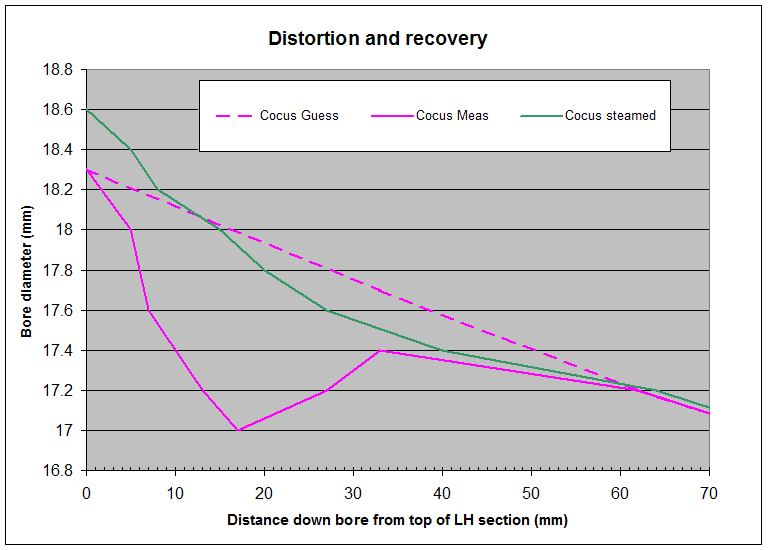Recovery |
||||||||||||||||||||||||||||||||
You can see the worse case error has dropped from +0.6 / -0.6mm when strangled, to 0.5mm when steamed and aired, and then to only 0.2mm after constraining, a six-fold improvement! And we could probably do better still by making the straightjacket a little undersize. Those who bend wood for musical purposes find they need to "overbend" a little to end up where they want to be. The wood springs back a little. We can expect this to happen to us too. The proof of the pudding...... is traditionally located in the eating. So, can we really cure a real flute from the distortions of the past, by the same processes that got us there? I resolved to find out using the cocuswood strangled flute. I opted for the approach used by violin, guitar and harpsichord makers, suitably adapted for flutes, but there would be many possible approaches. This method offers minimum water uptake and so speedy recovery. I turned up a brass plug following the bore shape I guessed at for the cocuswood strangled flute. Holding the tenon in boiling water, and then pushing the heated plug into it produced steam, which infuses into and softens the wood. Each time I did it, I could push the plug a little further, until it finally reached the point I wanted. I let the wood cool and dry with the plug in place, to prevent it sneaking back when my back was turned. (If you want to try this yourself on an affected flute, be careful to constrain the outside of the tip of the tenon from expanding too far, as the thin wood of the tenon is at considerable risk of splitting from the wedging action of the plug. Paradoxically, wrapping some thread around the tip as mentioned above might be just the answer!) You can see the result in this next graph, with the steamed cocuswood flute in green. Comparing my previous guess (pink dashed) with what we have now, it looks like I might have overdone it at the tenon tip, but that's easily fixed if necessary with the straightjacket approach. But looking at the steeper bore taper down around the 60-70mm mark, I'm also wondering if this approach might not have reached far enough into the thicker wood just beyond the tenon, circa 30-40mm. A longer, slower soak might do that, combined with a tapered plug on the inside, and a constraining ring on the outside. But the flute has to be far better off now than with the constriction in its throat seen on the pink curve! I decided to let its performance tell me if we're done yet.
A Happy EndingThe strangled cocuswood flute is now back together, and working very nicely. It is impossible to say how important fixing the choke in the top tenon was, as I also found lots of other little things that warranted attention along the way. This is normal with old flutes. They might have one or two dead-obvious things wrong with them, which is usually why they were sent in for attention. But it's often the accumulated effect of a dozen or more little unnoticed problems that continue to pull an old flute's performance down. It's like layers on an onion - they can seem to go on forever. But if you want to give the flute back its original joie-de-vivre, every one of them has to be detected and ruthlessly eradicated. Bore strangulation is now a new one on the agenda. Flute, heal thyself [Luke 4:23](See, it's true. Even the devil can misquote scripture! Chapter and verse.) Our experience with the test tenon might even bring us some hope for a self cure for strangled flutes. Imagine you have a flute with bore compression. You remove the thread-band tourniquet and replace it with something that won't restrict expansion, say cork. You put the flute back in service, meaning it gets subjected to wide humidity cycling but now without constraint. If our test tenon's recuperative experience is any guide, slowly the damage might be undone. At least you know it won't be getting any worse! If that were to happen, we might notice that the corked tenon became tighter over a period than it had been when first installed. That would be a good sign, suggesting the tenon was recuperating, but should also be regarded as a warning that excessive force could soon be applied to the socket. It would be important to ease any such tightening, until equilibrium was once more restored. Wrapping it up (get it?)Puns aside, I don't think there's much point in attempting much more on the test tenon, as we're now getting into finer points, which is likely to depend on matters like how compressed a real tenon is, what timber it's made from, how thick it is, how long the damage was sustained over, how long since the damage was sustained, and so on. But we can certainly thank our test tenon for confirming how this compression comes about, and offering us some hope that it can be reversed or at least ameliorated. I'm very happy with the in-extremis test procedure adopted. In just over a week, we were able to simulate what might have taken years under normal circumstances, and yet end up with entirely plausible results. And discover an unexpected side effect. And explore a possible road to recovery. Rewarding! And to apply our new-found
knowledge successfully to a real-life patient and effect a cure.
Priceless!
|

